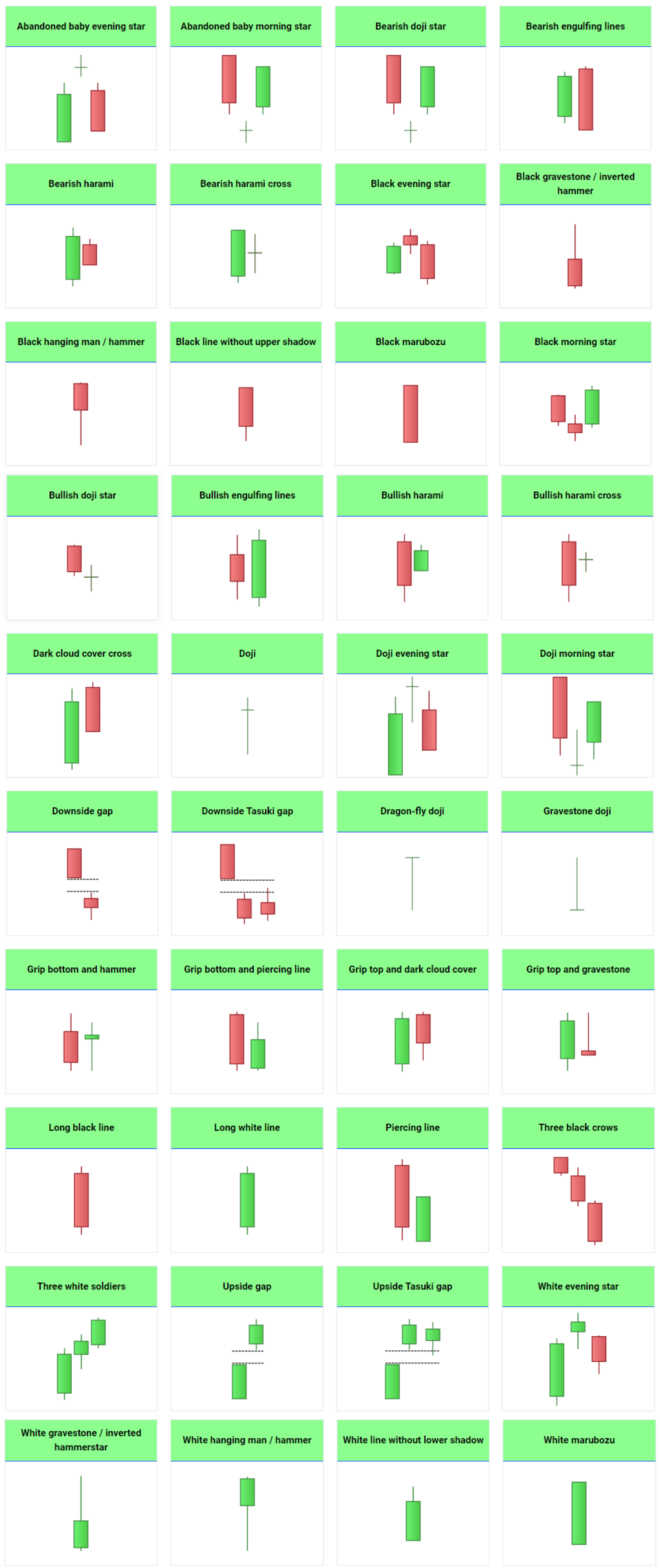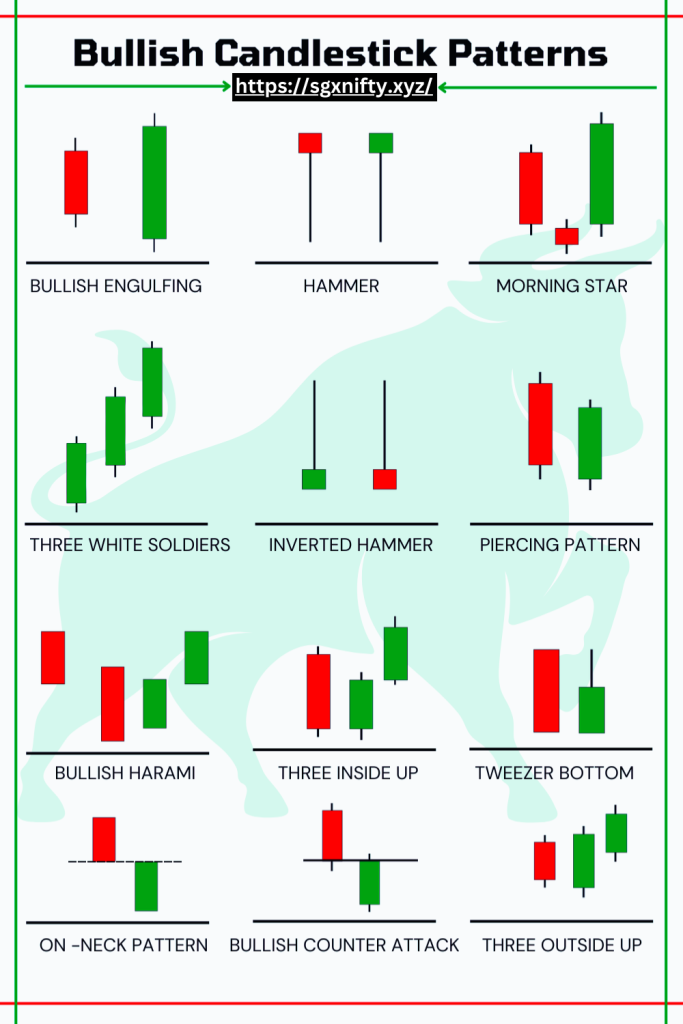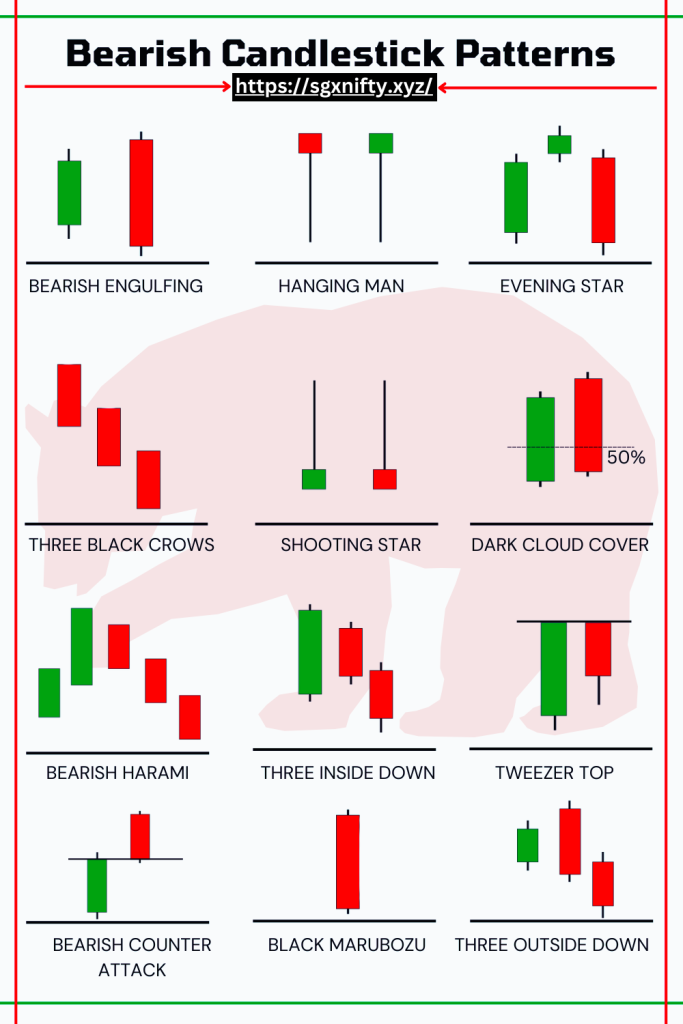Download our “All Candlestick Patterns PDF” to gain access to a wealth of information on various candlestick formations, their interpretations, and practical applications in trading.
Welcome to the world of candlestick patterns, where centuries-old Japanese techniques meet modern trading strategies.
In this comprehensive guide, we delve into the intricacies of candlestick patterns and unveil their significance in the realm of financial markets. Whether you’re a seasoned trader or a novice investor, understanding these patterns can elevate your trading game to new heights.
Download Link For The candlestick Bible PDF
All Candlestick Patterns

Download Here All Candlestick Patterns Pdf
35 Powerful Candlestick Patterns



Here are 35 powerful candlestick patterns along with their best features:
| Candlestick Pattern | Description | Additional Features |
|---|---|---|
| Doji | Indicates market indecision and potential reversal. | – Can appear in various shapes and sizes. – Confirmation needed from subsequent price action. |
| Hammer | Bullish reversal signal characterized by a long lower wick. | – Requires confirmation from subsequent price action. – Lower shadow should be at least twice the length of the body. |
| Hanging Man | Bearish reversal signal, similar to the hammer but appears at the peak of an uptrend. | – Signifies potential trend reversal. – Requires confirmation from subsequent candlesticks. |
| Shooting Star | Bearish reversal signal with a small body and long upper wick. | – Indicates potential reversal in an uptrend. – Confirmation needed from subsequent price action. |
| Inverted Hammer | Bullish reversal signal with a long upper wick and small body. | – Typically appears at the bottom of a downtrend. – Requires confirmation from subsequent candlesticks. |
| Bullish Engulfing | Bullish reversal pattern where the second candlestick completely engulfs the first. | – Strong bullish signal when it appears at the end of a downtrend. – Indicates a shift from selling pressure to buying pressure. |
| Bearish Engulfing | Bearish reversal pattern opposite to bullish engulfing. | – Strong bearish signal when it appears at the end of an uptrend. – Indicates a shift from buying pressure to selling pressure. |
| Piercing Line | Bullish reversal signal formed after a downtrend. | – Second candlestick should close above the midpoint of the first candlestick. – Indicates potential trend reversal when preceded by a downtrend. |
| Dark Cloud Cover | Bearish reversal signal formed after an uptrend. | – Second candlestick should open above the previous candle’s high. – Indicates potential trend reversal when preceded by an uptrend. |
| Morning Star | Bullish reversal pattern consisting of three candles – a long bearish, a small-bodied, and a bullish candle. | – Signals potential reversal from bearish to bullish. – Requires confirmation from subsequent price action. |
| Evening Star | Bearish reversal pattern opposite to the morning star. | – Signals potential reversal from bullish to bearish. – Requires confirmation from subsequent candlesticks. |
| Three White Soldiers | Bullish reversal pattern formed by three consecutive long bullish candles. | – Indicates strong buying pressure and potential trend reversal. – Requires confirmation from subsequent price action. |
| Three Black Crows | Bearish reversal pattern opposite to three white soldiers. | – Indicates strong selling pressure and potential trend reversal. – Requires confirmation from subsequent candlesticks. |
| Bullish Harami | Bullish reversal pattern characterized by a small candlestick inside a larger one. | – Requires confirmation from subsequent candlesticks. – Suggests a potential shift in market sentiment from bearish to bullish. |
| Bearish Harami | Bearish reversal pattern opposite to bullish harami. | – Requires confirmation from subsequent candlesticks. – Suggests a potential shift in market sentiment from bullish to bearish. |
| Bullish Belt Hold | Bullish signal with a long white candlestick that opens at or near the low and closes near the high. | – Indicates strong buying pressure throughout the session. – Typically occurs after a downtrend. |
| Bearish Belt Hold | Bearish signal opposite to bullish belt hold. | – Indicates strong selling pressure throughout the session. – Typically occurs after an uptrend. |
| Marubozu | Bullish or bearish reversal pattern with a long body and little to no wicks. | – Signifies strong buying or selling pressure depending on the color. – Little to no wicks indicate dominance by buyers or sellers. |
| Tweezer Tops | Bearish reversal pattern with two candlesticks at the peak of an uptrend. | – Requires confirmation from subsequent candlesticks. – Indicates potential exhaustion of buying pressure. |
| Tweezer Bottoms | Bullish reversal pattern opposite to tweezer tops. | – Requires confirmation from subsequent candlesticks. – Indicates potential exhaustion of selling pressure. |
| Bearish Abandoned Baby | Bearish reversal pattern characterized by a gap down after a doji. | – Requires confirmation from subsequent candlesticks. – Indicates potential reversal in an uptrend. |
| Bullish Abandoned Baby | Bullish reversal pattern opposite to bearish abandoned baby. | – Requires confirmation from subsequent candlesticks. – Indicates potential reversal in a downtrend. |
| Upside Tasuki Gap | Bullish continuation pattern with a gap up followed by two inside days. | – Indicates potential continuation of an uptrend. – Second day’s close should be above the first day’s close. |
| Downside Tasuki Gap | Bearish continuation pattern opposite to upside tasuki gap. | – Indicates potential continuation of a downtrend. – Second day’s close should be below the first day’s close. |
| Kicking | Bullish or bearish reversal pattern with one candlestick completely engulfing the prior candlestick. | – Strong signal when the prior candlestick is completely engulfed. – Indicates a decisive shift in market sentiment. |
| Gravestone Doji | Bearish reversal pattern with a long upper wick and no lower wick. | – Indicates potential reversal in an uptrend. – Requires confirmation from subsequent candlesticks. |
| Dragonfly Doji | Bullish reversal pattern with a long lower wick and no upper wick. | – Indicates potential reversal in a downtrend. – Requires confirmation from subsequent candlesticks. |
| Long-Legged Doji | Indicates market indecision with long upper and lower wicks. | – Indicates uncertainty in the market. – Requires confirmation from subsequent price action. |
| Spinning Top | Indicates market indecision with small body and long upper and lower wicks. | – Suggests a battle between buyers and sellers. – Requires confirmation from subsequent candlesticks. |
| Rickshaw Man | Indicates market indecision with a small body and long wicks. | – Signifies uncertainty in the market. – Requires confirmation from subsequent candlesticks. |
| Harami Cross | Bullish or bearish reversal pattern with a small candlestick inside a larger one, indicating uncertainty. | – Requires confirmation from subsequent candlesticks. – Indicates potential reversal depending on the direction of the subsequent candlestick. |
| Meeting Lines | Bullish or bearish continuation pattern with two candlesticks of opposite colors having the same close. | – Indicates potential continuation of the current trend. – Requires confirmation from subsequent candlesticks. |
| Separating Lines | Bullish or bearish continuation pattern with two candlesticks of the same | |
| Mat Hold | Bullish continuation pattern where a long white candle is followed by a series of small-bodied candles. | – Indicates |
These candlestick patterns are widely used by traders to analyze market sentiment and potential price movements.
Download 35 powerful candlestick patterns pdf
Intricacies of Candlestick Patterns and Their Significance
Candlestick patterns are like the language of the financial markets, conveying crucial information about price movements and market sentiment. Whether you’re an experienced trader or just starting out, mastering these patterns can significantly enhance your ability to analyze and predict market trends.
One of the key aspects of candlestick patterns is their ability to provide insights into market psychology and the balance between buyers and sellers. By studying the various shapes and formations of candlesticks, traders can glean valuable clues about the future direction of prices.
For example, patterns like the “hammer” or “doji” signal potential trend reversals. A hammer occurs when the price opens significantly lower than its close, but rallies to close near its high. This suggests that buyers are stepping in to push prices higher after a period of decline, potentially signaling a bullish reversal.
Similarly, a doji occurs when the open and close prices are virtually the same, indicating indecision in the market. This could signal a potential reversal or a period of consolidation before the next significant move.
Other patterns, such as “engulfing” patterns or “morning star” formations, provide insights into shifts in market momentum and sentiment. An engulfing pattern occurs when a candlestick completely engulfs the previous candlestick, indicating a strong reversal in momentum.
The morning star pattern, on the other hand, consists of three candlesticks – a long bearish candle, followed by a small-bodied candle or doji, and then a long bullish candle. This pattern suggests a potential reversal from a downtrend to an uptrend.
By recognizing these patterns and understanding their significance, traders can make more informed decisions about when to enter or exit trades, manage risk, and capitalize on potential opportunities in the market.
However, it’s important to note that candlestick patterns should not be used in isolation. They are most effective when combined with other technical indicators and analysis techniques to confirm signals and validate trading strategies.
In summary, mastering candlestick patterns can be a powerful tool for traders of all levels, providing valuable insights into market dynamics and helping to navigate the complexities of the financial markets with greater confidence and success.
